Unilever's Business Strategy: Analysis, Recommendations, and Growth
VerifiedAdded on 2023/06/07
|14
|4523
|351
Report
AI Summary
This report provides a detailed analysis of Unilever's business strategy. It begins with an introduction to strategic management planning and its importance for companies like Unilever. Part A of the report includes a PESTLE and SWOT analysis of Unilever, evaluating its resources and capabilities. It also examines the competitive environment using Porter's Five Forces model, identifies Unilever's competitive advantages, and outlines valid strategies and tactical objectives. Part B delves into different strategic directions using the Ansoff Matrix, recommends appropriate growth platforms and strategies, and evaluates methods for monitoring the chosen strategy. The report concludes with a summary of findings and recommendations, supported by relevant references. The report emphasizes Unilever's commitment to sustainable practices and achieving its strategic objectives through initiatives like the Unilever Sustainable Living Plan.
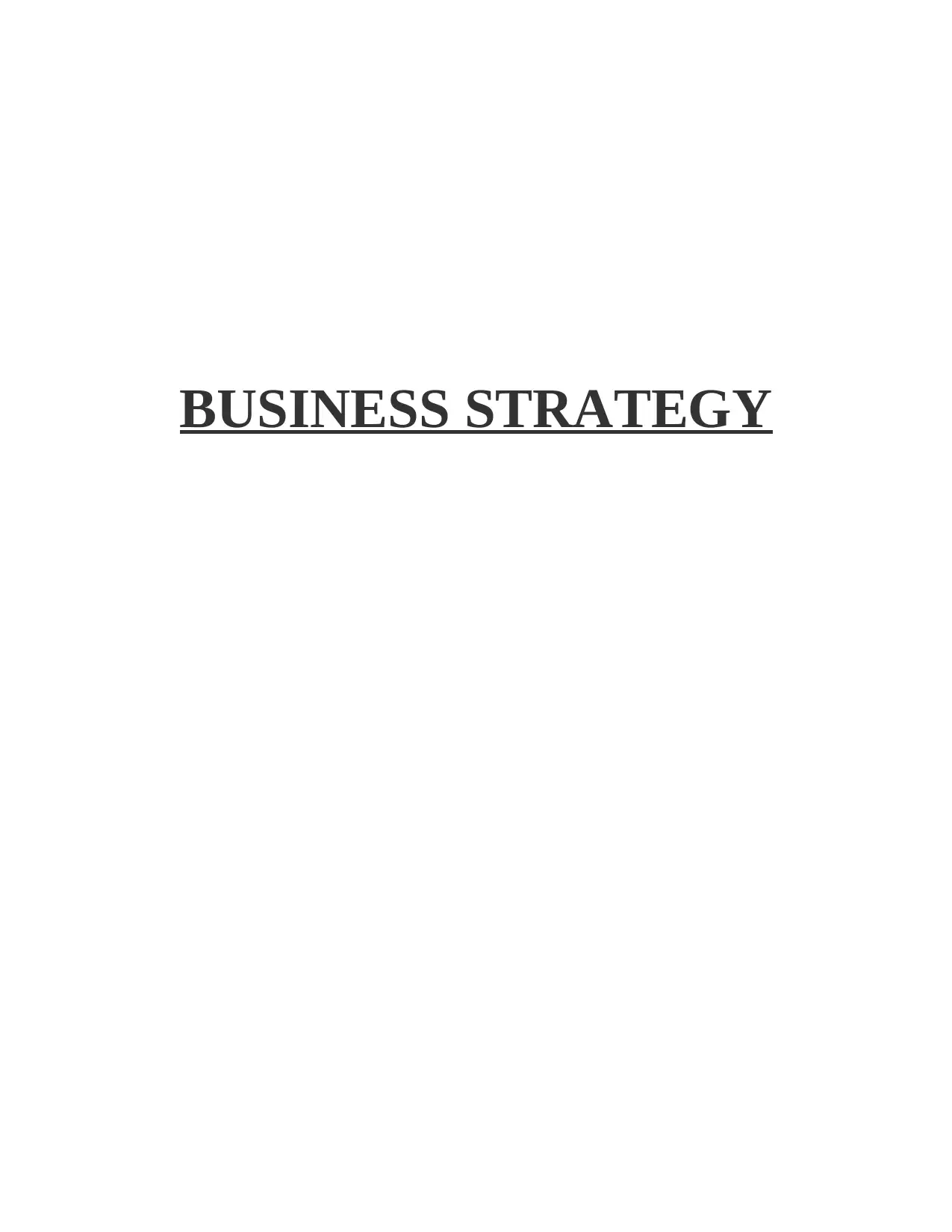
BUSINESS STRATEGY
Paraphrase This Document
Need a fresh take? Get an instant paraphrase of this document with our AI Paraphraser
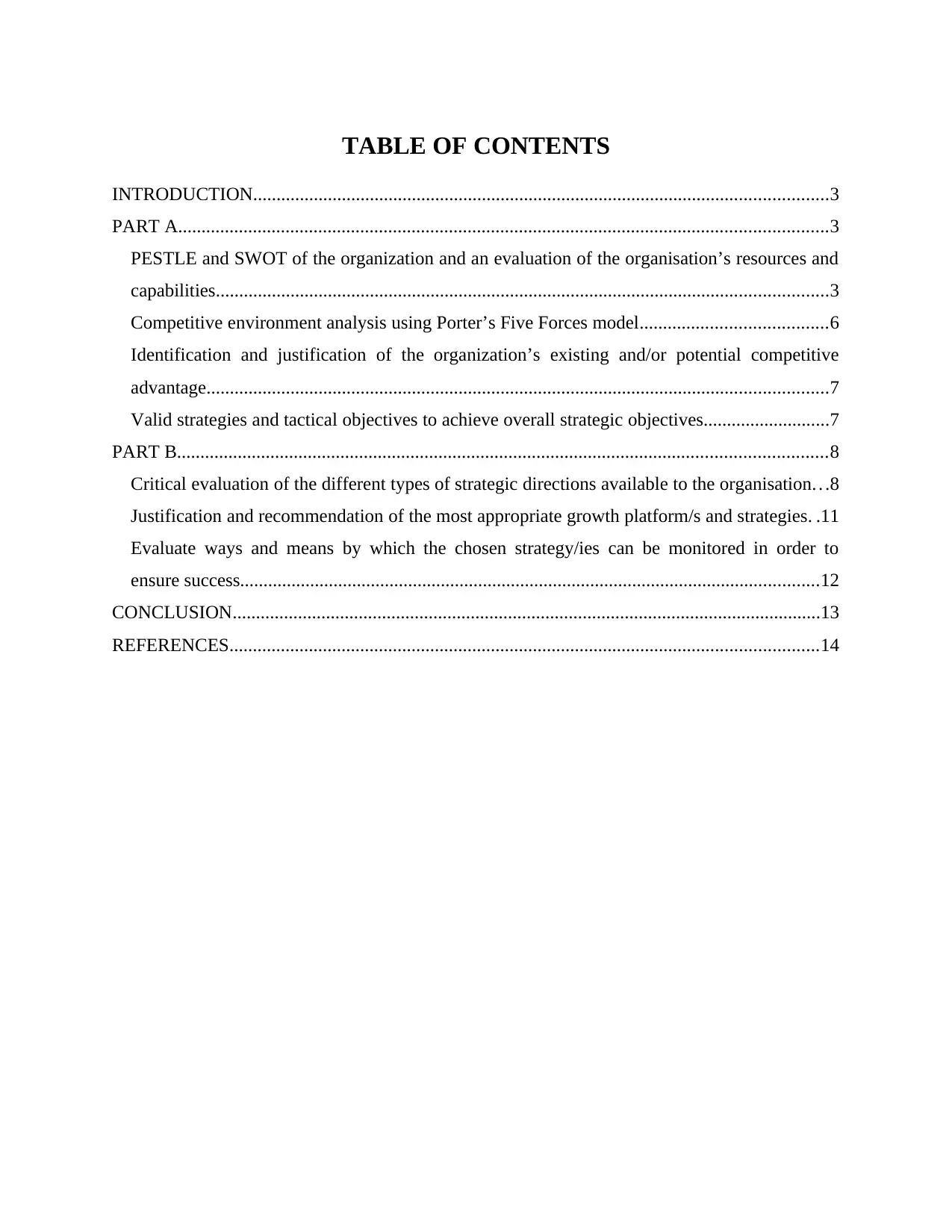
TABLE OF CONTENTS
INTRODUCTION...........................................................................................................................3
PART A...........................................................................................................................................3
PESTLE and SWOT of the organization and an evaluation of the organisation’s resources and
capabilities...................................................................................................................................3
Competitive environment analysis using Porter’s Five Forces model........................................6
Identification and justification of the organization’s existing and/or potential competitive
advantage.....................................................................................................................................7
Valid strategies and tactical objectives to achieve overall strategic objectives...........................7
PART B...........................................................................................................................................8
Critical evaluation of the different types of strategic directions available to the organisation. . .8
Justification and recommendation of the most appropriate growth platform/s and strategies. .11
Evaluate ways and means by which the chosen strategy/ies can be monitored in order to
ensure success............................................................................................................................12
CONCLUSION..............................................................................................................................13
REFERENCES..............................................................................................................................14
INTRODUCTION...........................................................................................................................3
PART A...........................................................................................................................................3
PESTLE and SWOT of the organization and an evaluation of the organisation’s resources and
capabilities...................................................................................................................................3
Competitive environment analysis using Porter’s Five Forces model........................................6
Identification and justification of the organization’s existing and/or potential competitive
advantage.....................................................................................................................................7
Valid strategies and tactical objectives to achieve overall strategic objectives...........................7
PART B...........................................................................................................................................8
Critical evaluation of the different types of strategic directions available to the organisation. . .8
Justification and recommendation of the most appropriate growth platform/s and strategies. .11
Evaluate ways and means by which the chosen strategy/ies can be monitored in order to
ensure success............................................................................................................................12
CONCLUSION..............................................................................................................................13
REFERENCES..............................................................................................................................14
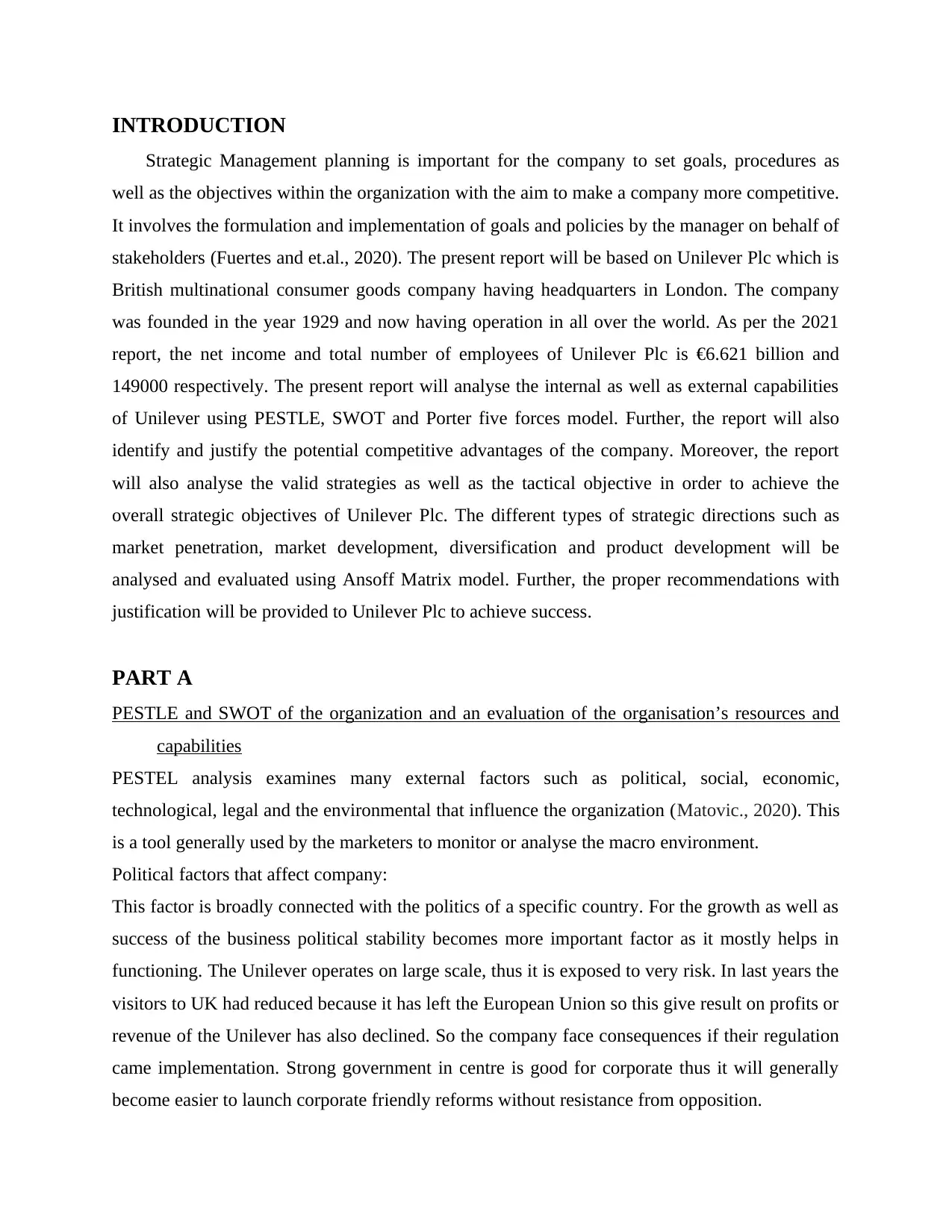
INTRODUCTION
Strategic Management planning is important for the company to set goals, procedures as
well as the objectives within the organization with the aim to make a company more competitive.
It involves the formulation and implementation of goals and policies by the manager on behalf of
stakeholders (Fuertes and et.al., 2020). The present report will be based on Unilever Plc which is
British multinational consumer goods company having headquarters in London. The company
was founded in the year 1929 and now having operation in all over the world. As per the 2021
report, the net income and total number of employees of Unilever Plc is €6.621 billion and
149000 respectively. The present report will analyse the internal as well as external capabilities
of Unilever using PESTLE, SWOT and Porter five forces model. Further, the report will also
identify and justify the potential competitive advantages of the company. Moreover, the report
will also analyse the valid strategies as well as the tactical objective in order to achieve the
overall strategic objectives of Unilever Plc. The different types of strategic directions such as
market penetration, market development, diversification and product development will be
analysed and evaluated using Ansoff Matrix model. Further, the proper recommendations with
justification will be provided to Unilever Plc to achieve success.
PART A
PESTLE and SWOT of the organization and an evaluation of the organisation’s resources and
capabilities
PESTEL analysis examines many external factors such as political, social, economic,
technological, legal and the environmental that influence the organization (Matovic., 2020). This
is a tool generally used by the marketers to monitor or analyse the macro environment.
Political factors that affect company:
This factor is broadly connected with the politics of a specific country. For the growth as well as
success of the business political stability becomes more important factor as it mostly helps in
functioning. The Unilever operates on large scale, thus it is exposed to very risk. In last years the
visitors to UK had reduced because it has left the European Union so this give result on profits or
revenue of the Unilever has also declined. So the company face consequences if their regulation
came implementation. Strong government in centre is good for corporate thus it will generally
become easier to launch corporate friendly reforms without resistance from opposition.
Strategic Management planning is important for the company to set goals, procedures as
well as the objectives within the organization with the aim to make a company more competitive.
It involves the formulation and implementation of goals and policies by the manager on behalf of
stakeholders (Fuertes and et.al., 2020). The present report will be based on Unilever Plc which is
British multinational consumer goods company having headquarters in London. The company
was founded in the year 1929 and now having operation in all over the world. As per the 2021
report, the net income and total number of employees of Unilever Plc is €6.621 billion and
149000 respectively. The present report will analyse the internal as well as external capabilities
of Unilever using PESTLE, SWOT and Porter five forces model. Further, the report will also
identify and justify the potential competitive advantages of the company. Moreover, the report
will also analyse the valid strategies as well as the tactical objective in order to achieve the
overall strategic objectives of Unilever Plc. The different types of strategic directions such as
market penetration, market development, diversification and product development will be
analysed and evaluated using Ansoff Matrix model. Further, the proper recommendations with
justification will be provided to Unilever Plc to achieve success.
PART A
PESTLE and SWOT of the organization and an evaluation of the organisation’s resources and
capabilities
PESTEL analysis examines many external factors such as political, social, economic,
technological, legal and the environmental that influence the organization (Matovic., 2020). This
is a tool generally used by the marketers to monitor or analyse the macro environment.
Political factors that affect company:
This factor is broadly connected with the politics of a specific country. For the growth as well as
success of the business political stability becomes more important factor as it mostly helps in
functioning. The Unilever operates on large scale, thus it is exposed to very risk. In last years the
visitors to UK had reduced because it has left the European Union so this give result on profits or
revenue of the Unilever has also declined. So the company face consequences if their regulation
came implementation. Strong government in centre is good for corporate thus it will generally
become easier to launch corporate friendly reforms without resistance from opposition.
⊘ This is a preview!⊘
Do you want full access?
Subscribe today to unlock all pages.

Trusted by 1+ million students worldwide

Economic factors-
This factor is mainly related with economic condition of particular country. Here, economic
factor is plays important role for the industry thus it is not under control of the industry but it
generally gives impact on business operations. Booming economic is more profitable for the
companies. If the country economy is stable then it is good sign for the company. Employment is
an important factor of economic in deciding company prospects in the nation. For example, if
large number of people are unemployed, then it can help company in reducing their cost. But at
the same time it can be mean that there is lesser number of people to buy the company product in
the market.
Social factors-
Social factors such as latest trends, lifestyles, cultures, fashions and many more. As being well
recognized brand around the world the revenue of the organization can also affect by different
factors such as consumer demographics, growth rate, gender ratio, cultures etc. The company
also has launch products as well as market them in effective way that is appeals to social
demographics. The Unilever offer products to all level people that is low income group, middle
class and the high class people.
Technological factors-
These factors are generally involved with the all technologies that are mostly evolving day to day
as well as making the lives easier. Unilever is engaged in providing good quality products so,
they have to focus on updating its technologies. Constant improvement in operation of the
businesses are generally required to increase efficiency as well as decrease costs.
Legal factors-
Legal factors are mostly connected with all laws as well as rules of particular country under
which organization operates. So Unilever needs to protect all its patents. The company also,
considers that the company should be informed about legalities as well as processes. Generally
this creates trust in the customers mind and so the organization gains customers loyalty as well.
Environmental factors-
These factors are more connected with environmental activity that are generally followed by many
people and also undertaken by many firms. The Unilever has successfully capable to project
themselves as environmental friendly organization. Even the organization is dedicated towards to
achieve the goal of 100 per cent plastic packaging to be reusable.
This factor is mainly related with economic condition of particular country. Here, economic
factor is plays important role for the industry thus it is not under control of the industry but it
generally gives impact on business operations. Booming economic is more profitable for the
companies. If the country economy is stable then it is good sign for the company. Employment is
an important factor of economic in deciding company prospects in the nation. For example, if
large number of people are unemployed, then it can help company in reducing their cost. But at
the same time it can be mean that there is lesser number of people to buy the company product in
the market.
Social factors-
Social factors such as latest trends, lifestyles, cultures, fashions and many more. As being well
recognized brand around the world the revenue of the organization can also affect by different
factors such as consumer demographics, growth rate, gender ratio, cultures etc. The company
also has launch products as well as market them in effective way that is appeals to social
demographics. The Unilever offer products to all level people that is low income group, middle
class and the high class people.
Technological factors-
These factors are generally involved with the all technologies that are mostly evolving day to day
as well as making the lives easier. Unilever is engaged in providing good quality products so,
they have to focus on updating its technologies. Constant improvement in operation of the
businesses are generally required to increase efficiency as well as decrease costs.
Legal factors-
Legal factors are mostly connected with all laws as well as rules of particular country under
which organization operates. So Unilever needs to protect all its patents. The company also,
considers that the company should be informed about legalities as well as processes. Generally
this creates trust in the customers mind and so the organization gains customers loyalty as well.
Environmental factors-
These factors are more connected with environmental activity that are generally followed by many
people and also undertaken by many firms. The Unilever has successfully capable to project
themselves as environmental friendly organization. Even the organization is dedicated towards to
achieve the goal of 100 per cent plastic packaging to be reusable.
Paraphrase This Document
Need a fresh take? Get an instant paraphrase of this document with our AI Paraphraser
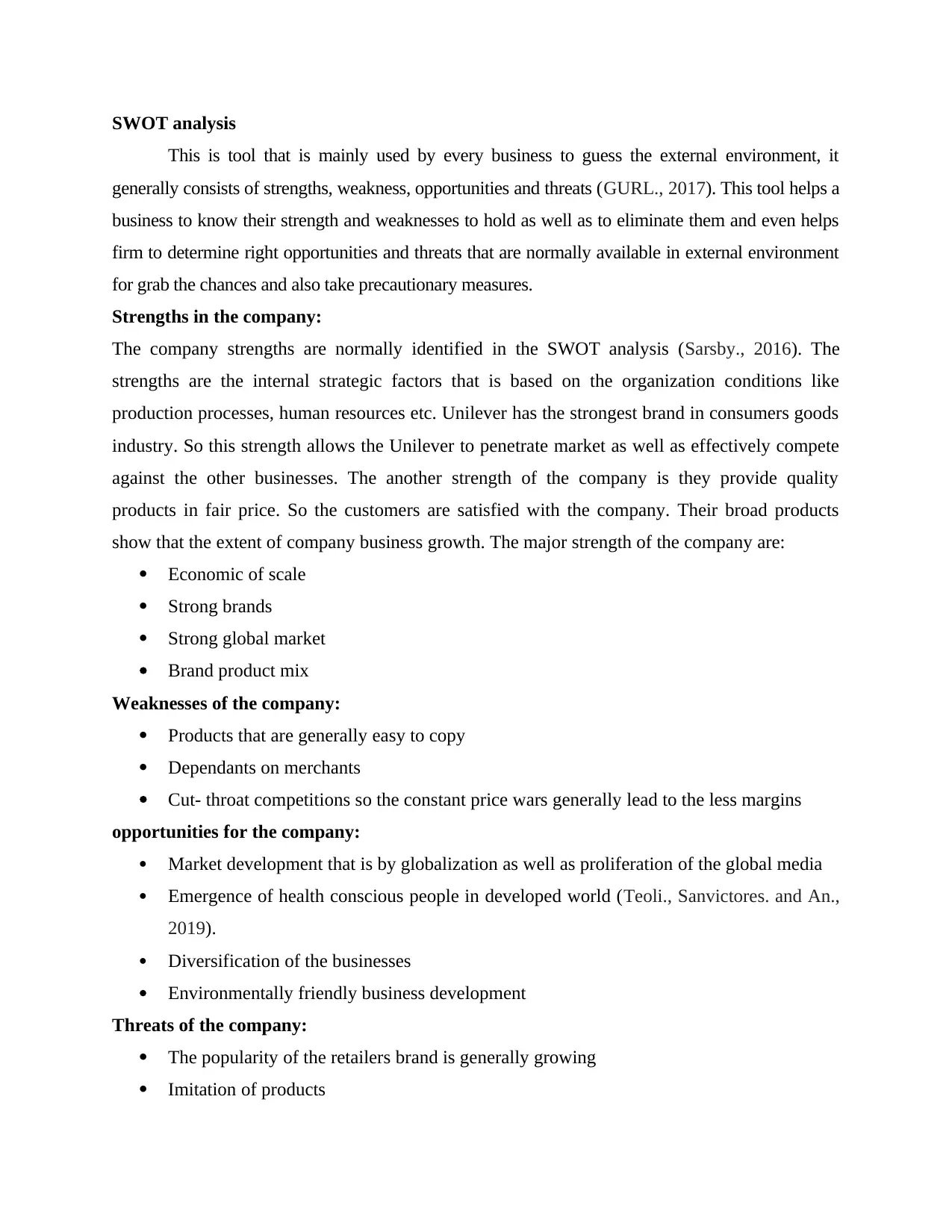
SWOT analysis
This is tool that is mainly used by every business to guess the external environment, it
generally consists of strengths, weakness, opportunities and threats (GURL., 2017). This tool helps a
business to know their strength and weaknesses to hold as well as to eliminate them and even helps
firm to determine right opportunities and threats that are normally available in external environment
for grab the chances and also take precautionary measures.
Strengths in the company:
The company strengths are normally identified in the SWOT analysis (Sarsby., 2016). The
strengths are the internal strategic factors that is based on the organization conditions like
production processes, human resources etc. Unilever has the strongest brand in consumers goods
industry. So this strength allows the Unilever to penetrate market as well as effectively compete
against the other businesses. The another strength of the company is they provide quality
products in fair price. So the customers are satisfied with the company. Their broad products
show that the extent of company business growth. The major strength of the company are:
Economic of scale
Strong brands
Strong global market
Brand product mix
Weaknesses of the company:
Products that are generally easy to copy
Dependants on merchants
Cut- throat competitions so the constant price wars generally lead to the less margins
opportunities for the company:
Market development that is by globalization as well as proliferation of the global media
Emergence of health conscious people in developed world (Teoli., Sanvictores. and An.,
2019).
Diversification of the businesses
Environmentally friendly business development
Threats of the company:
The popularity of the retailers brand is generally growing
Imitation of products
This is tool that is mainly used by every business to guess the external environment, it
generally consists of strengths, weakness, opportunities and threats (GURL., 2017). This tool helps a
business to know their strength and weaknesses to hold as well as to eliminate them and even helps
firm to determine right opportunities and threats that are normally available in external environment
for grab the chances and also take precautionary measures.
Strengths in the company:
The company strengths are normally identified in the SWOT analysis (Sarsby., 2016). The
strengths are the internal strategic factors that is based on the organization conditions like
production processes, human resources etc. Unilever has the strongest brand in consumers goods
industry. So this strength allows the Unilever to penetrate market as well as effectively compete
against the other businesses. The another strength of the company is they provide quality
products in fair price. So the customers are satisfied with the company. Their broad products
show that the extent of company business growth. The major strength of the company are:
Economic of scale
Strong brands
Strong global market
Brand product mix
Weaknesses of the company:
Products that are generally easy to copy
Dependants on merchants
Cut- throat competitions so the constant price wars generally lead to the less margins
opportunities for the company:
Market development that is by globalization as well as proliferation of the global media
Emergence of health conscious people in developed world (Teoli., Sanvictores. and An.,
2019).
Diversification of the businesses
Environmentally friendly business development
Threats of the company:
The popularity of the retailers brand is generally growing
Imitation of products
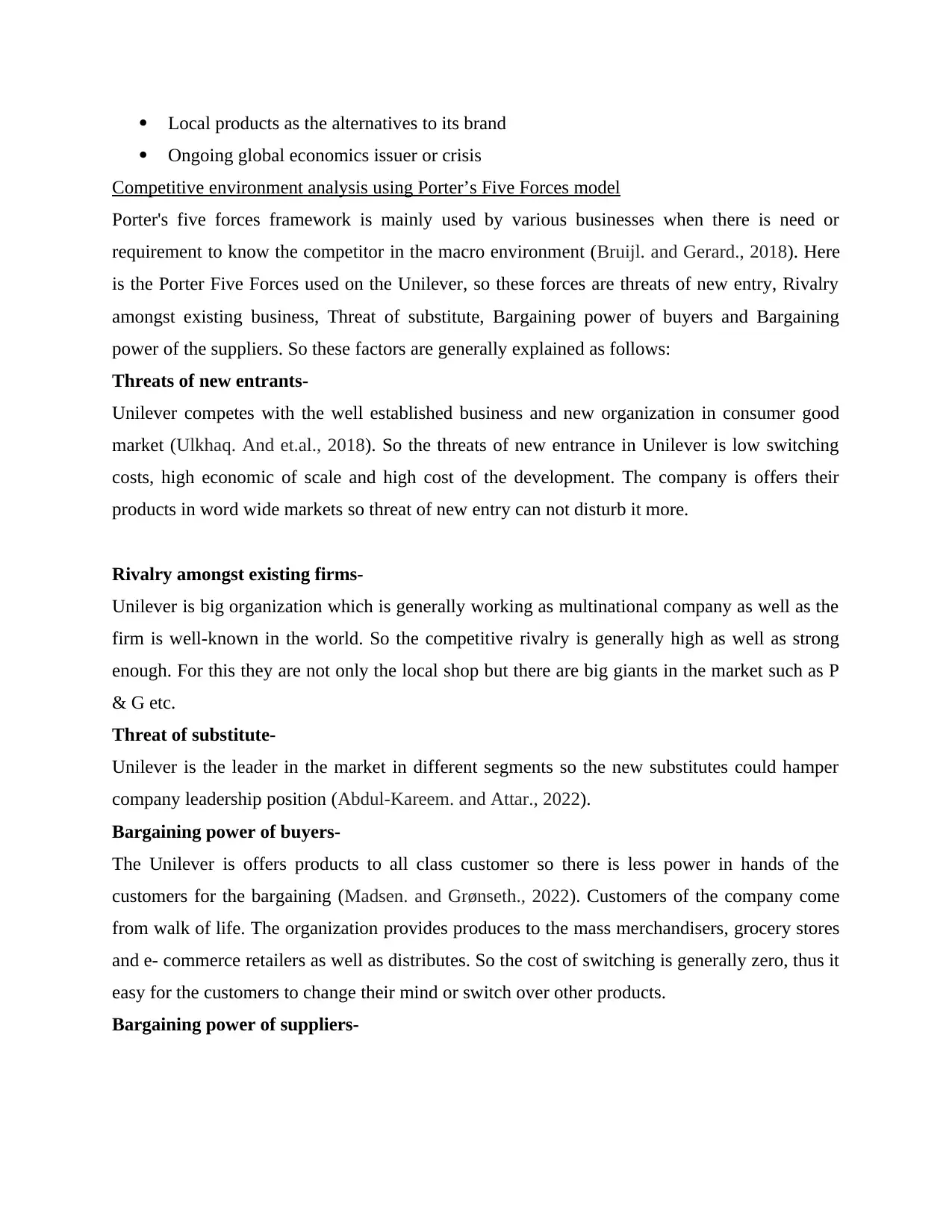
Local products as the alternatives to its brand
Ongoing global economics issuer or crisis
Competitive environment analysis using Porter’s Five Forces model
Porter's five forces framework is mainly used by various businesses when there is need or
requirement to know the competitor in the macro environment (Bruijl. and Gerard., 2018). Here
is the Porter Five Forces used on the Unilever, so these forces are threats of new entry, Rivalry
amongst existing business, Threat of substitute, Bargaining power of buyers and Bargaining
power of the suppliers. So these factors are generally explained as follows:
Threats of new entrants-
Unilever competes with the well established business and new organization in consumer good
market (Ulkhaq. And et.al., 2018). So the threats of new entrance in Unilever is low switching
costs, high economic of scale and high cost of the development. The company is offers their
products in word wide markets so threat of new entry can not disturb it more.
Rivalry amongst existing firms-
Unilever is big organization which is generally working as multinational company as well as the
firm is well-known in the world. So the competitive rivalry is generally high as well as strong
enough. For this they are not only the local shop but there are big giants in the market such as P
& G etc.
Threat of substitute-
Unilever is the leader in the market in different segments so the new substitutes could hamper
company leadership position (Abdul-Kareem. and Attar., 2022).
Bargaining power of buyers-
The Unilever is offers products to all class customer so there is less power in hands of the
customers for the bargaining (Madsen. and Grønseth., 2022). Customers of the company come
from walk of life. The organization provides produces to the mass merchandisers, grocery stores
and e- commerce retailers as well as distributes. So the cost of switching is generally zero, thus it
easy for the customers to change their mind or switch over other products.
Bargaining power of suppliers-
Ongoing global economics issuer or crisis
Competitive environment analysis using Porter’s Five Forces model
Porter's five forces framework is mainly used by various businesses when there is need or
requirement to know the competitor in the macro environment (Bruijl. and Gerard., 2018). Here
is the Porter Five Forces used on the Unilever, so these forces are threats of new entry, Rivalry
amongst existing business, Threat of substitute, Bargaining power of buyers and Bargaining
power of the suppliers. So these factors are generally explained as follows:
Threats of new entrants-
Unilever competes with the well established business and new organization in consumer good
market (Ulkhaq. And et.al., 2018). So the threats of new entrance in Unilever is low switching
costs, high economic of scale and high cost of the development. The company is offers their
products in word wide markets so threat of new entry can not disturb it more.
Rivalry amongst existing firms-
Unilever is big organization which is generally working as multinational company as well as the
firm is well-known in the world. So the competitive rivalry is generally high as well as strong
enough. For this they are not only the local shop but there are big giants in the market such as P
& G etc.
Threat of substitute-
Unilever is the leader in the market in different segments so the new substitutes could hamper
company leadership position (Abdul-Kareem. and Attar., 2022).
Bargaining power of buyers-
The Unilever is offers products to all class customer so there is less power in hands of the
customers for the bargaining (Madsen. and Grønseth., 2022). Customers of the company come
from walk of life. The organization provides produces to the mass merchandisers, grocery stores
and e- commerce retailers as well as distributes. So the cost of switching is generally zero, thus it
easy for the customers to change their mind or switch over other products.
Bargaining power of suppliers-
⊘ This is a preview!⊘
Do you want full access?
Subscribe today to unlock all pages.

Trusted by 1+ million students worldwide
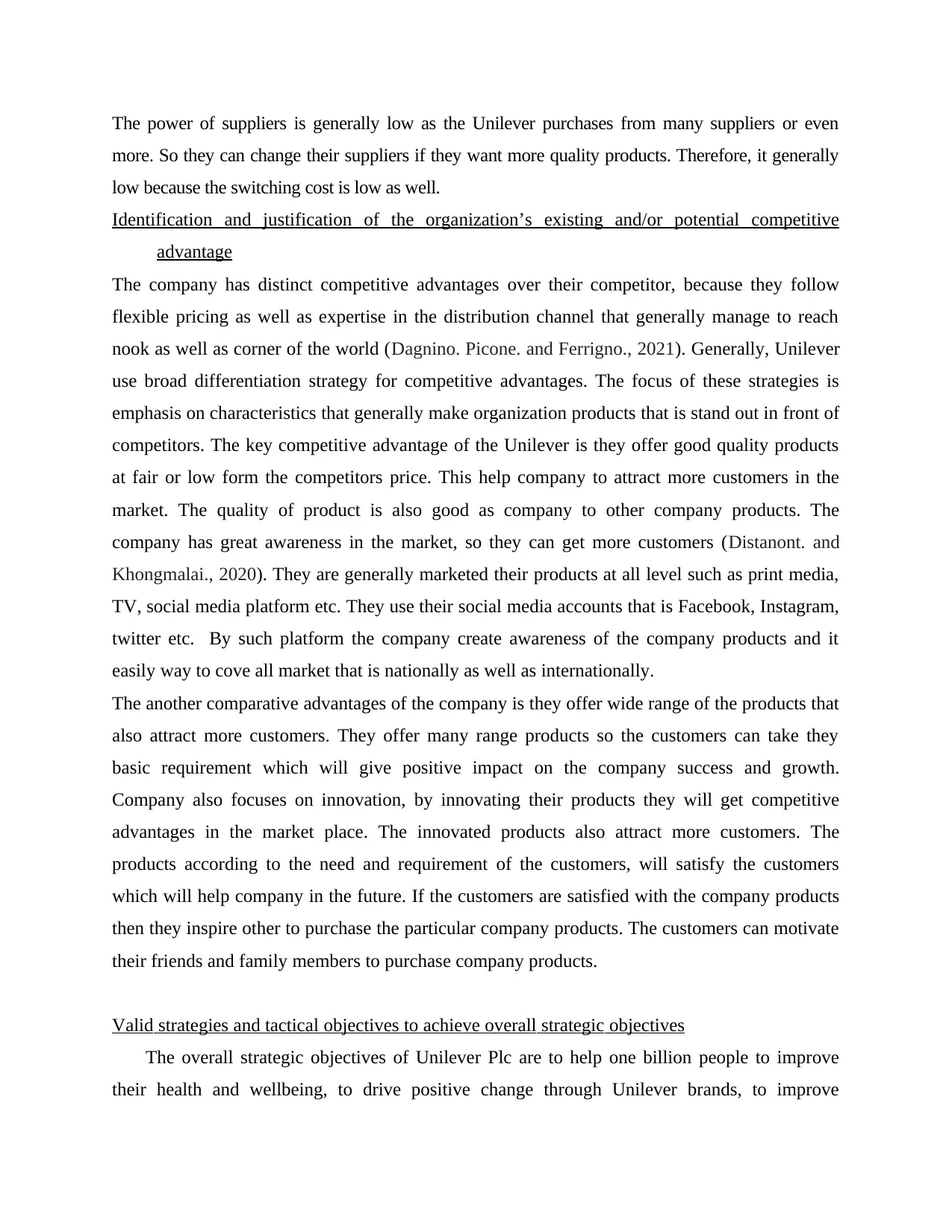
The power of suppliers is generally low as the Unilever purchases from many suppliers or even
more. So they can change their suppliers if they want more quality products. Therefore, it generally
low because the switching cost is low as well.
Identification and justification of the organization’s existing and/or potential competitive
advantage
The company has distinct competitive advantages over their competitor, because they follow
flexible pricing as well as expertise in the distribution channel that generally manage to reach
nook as well as corner of the world (Dagnino. Picone. and Ferrigno., 2021). Generally, Unilever
use broad differentiation strategy for competitive advantages. The focus of these strategies is
emphasis on characteristics that generally make organization products that is stand out in front of
competitors. The key competitive advantage of the Unilever is they offer good quality products
at fair or low form the competitors price. This help company to attract more customers in the
market. The quality of product is also good as company to other company products. The
company has great awareness in the market, so they can get more customers (Distanont. and
Khongmalai., 2020). They are generally marketed their products at all level such as print media,
TV, social media platform etc. They use their social media accounts that is Facebook, Instagram,
twitter etc. By such platform the company create awareness of the company products and it
easily way to cove all market that is nationally as well as internationally.
The another comparative advantages of the company is they offer wide range of the products that
also attract more customers. They offer many range products so the customers can take they
basic requirement which will give positive impact on the company success and growth.
Company also focuses on innovation, by innovating their products they will get competitive
advantages in the market place. The innovated products also attract more customers. The
products according to the need and requirement of the customers, will satisfy the customers
which will help company in the future. If the customers are satisfied with the company products
then they inspire other to purchase the particular company products. The customers can motivate
their friends and family members to purchase company products.
Valid strategies and tactical objectives to achieve overall strategic objectives
The overall strategic objectives of Unilever Plc are to help one billion people to improve
their health and wellbeing, to drive positive change through Unilever brands, to improve
more. So they can change their suppliers if they want more quality products. Therefore, it generally
low because the switching cost is low as well.
Identification and justification of the organization’s existing and/or potential competitive
advantage
The company has distinct competitive advantages over their competitor, because they follow
flexible pricing as well as expertise in the distribution channel that generally manage to reach
nook as well as corner of the world (Dagnino. Picone. and Ferrigno., 2021). Generally, Unilever
use broad differentiation strategy for competitive advantages. The focus of these strategies is
emphasis on characteristics that generally make organization products that is stand out in front of
competitors. The key competitive advantage of the Unilever is they offer good quality products
at fair or low form the competitors price. This help company to attract more customers in the
market. The quality of product is also good as company to other company products. The
company has great awareness in the market, so they can get more customers (Distanont. and
Khongmalai., 2020). They are generally marketed their products at all level such as print media,
TV, social media platform etc. They use their social media accounts that is Facebook, Instagram,
twitter etc. By such platform the company create awareness of the company products and it
easily way to cove all market that is nationally as well as internationally.
The another comparative advantages of the company is they offer wide range of the products that
also attract more customers. They offer many range products so the customers can take they
basic requirement which will give positive impact on the company success and growth.
Company also focuses on innovation, by innovating their products they will get competitive
advantages in the market place. The innovated products also attract more customers. The
products according to the need and requirement of the customers, will satisfy the customers
which will help company in the future. If the customers are satisfied with the company products
then they inspire other to purchase the particular company products. The customers can motivate
their friends and family members to purchase company products.
Valid strategies and tactical objectives to achieve overall strategic objectives
The overall strategic objectives of Unilever Plc are to help one billion people to improve
their health and wellbeing, to drive positive change through Unilever brands, to improve
Paraphrase This Document
Need a fresh take? Get an instant paraphrase of this document with our AI Paraphraser
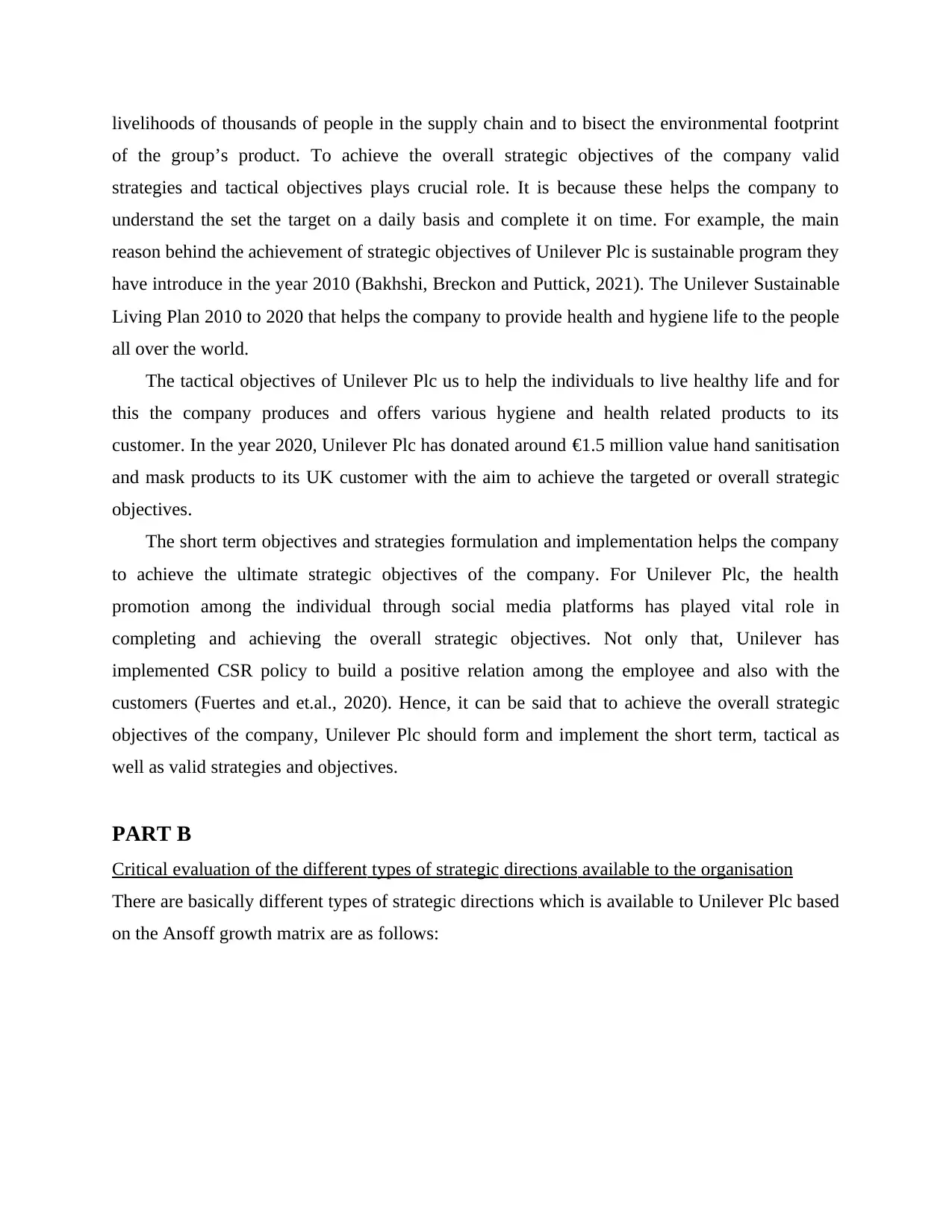
livelihoods of thousands of people in the supply chain and to bisect the environmental footprint
of the group’s product. To achieve the overall strategic objectives of the company valid
strategies and tactical objectives plays crucial role. It is because these helps the company to
understand the set the target on a daily basis and complete it on time. For example, the main
reason behind the achievement of strategic objectives of Unilever Plc is sustainable program they
have introduce in the year 2010 (Bakhshi, Breckon and Puttick, 2021). The Unilever Sustainable
Living Plan 2010 to 2020 that helps the company to provide health and hygiene life to the people
all over the world.
The tactical objectives of Unilever Plc us to help the individuals to live healthy life and for
this the company produces and offers various hygiene and health related products to its
customer. In the year 2020, Unilever Plc has donated around €1.5 million value hand sanitisation
and mask products to its UK customer with the aim to achieve the targeted or overall strategic
objectives.
The short term objectives and strategies formulation and implementation helps the company
to achieve the ultimate strategic objectives of the company. For Unilever Plc, the health
promotion among the individual through social media platforms has played vital role in
completing and achieving the overall strategic objectives. Not only that, Unilever has
implemented CSR policy to build a positive relation among the employee and also with the
customers (Fuertes and et.al., 2020). Hence, it can be said that to achieve the overall strategic
objectives of the company, Unilever Plc should form and implement the short term, tactical as
well as valid strategies and objectives.
PART B
Critical evaluation of the different types of strategic directions available to the organisation
There are basically different types of strategic directions which is available to Unilever Plc based
on the Ansoff growth matrix are as follows:
of the group’s product. To achieve the overall strategic objectives of the company valid
strategies and tactical objectives plays crucial role. It is because these helps the company to
understand the set the target on a daily basis and complete it on time. For example, the main
reason behind the achievement of strategic objectives of Unilever Plc is sustainable program they
have introduce in the year 2010 (Bakhshi, Breckon and Puttick, 2021). The Unilever Sustainable
Living Plan 2010 to 2020 that helps the company to provide health and hygiene life to the people
all over the world.
The tactical objectives of Unilever Plc us to help the individuals to live healthy life and for
this the company produces and offers various hygiene and health related products to its
customer. In the year 2020, Unilever Plc has donated around €1.5 million value hand sanitisation
and mask products to its UK customer with the aim to achieve the targeted or overall strategic
objectives.
The short term objectives and strategies formulation and implementation helps the company
to achieve the ultimate strategic objectives of the company. For Unilever Plc, the health
promotion among the individual through social media platforms has played vital role in
completing and achieving the overall strategic objectives. Not only that, Unilever has
implemented CSR policy to build a positive relation among the employee and also with the
customers (Fuertes and et.al., 2020). Hence, it can be said that to achieve the overall strategic
objectives of the company, Unilever Plc should form and implement the short term, tactical as
well as valid strategies and objectives.
PART B
Critical evaluation of the different types of strategic directions available to the organisation
There are basically different types of strategic directions which is available to Unilever Plc based
on the Ansoff growth matrix are as follows:
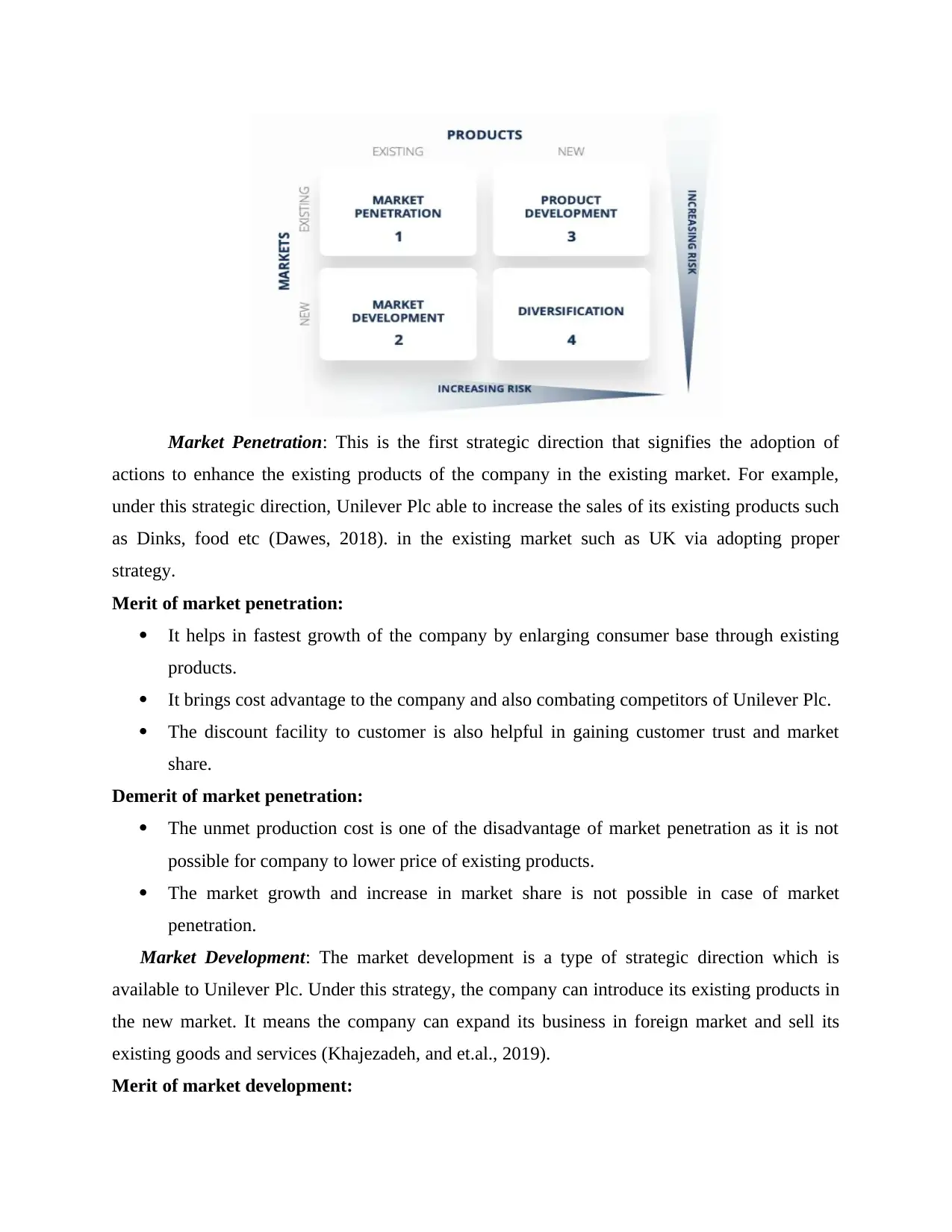
Market Penetration: This is the first strategic direction that signifies the adoption of
actions to enhance the existing products of the company in the existing market. For example,
under this strategic direction, Unilever Plc able to increase the sales of its existing products such
as Dinks, food etc (Dawes, 2018). in the existing market such as UK via adopting proper
strategy.
Merit of market penetration:
It helps in fastest growth of the company by enlarging consumer base through existing
products.
It brings cost advantage to the company and also combating competitors of Unilever Plc.
The discount facility to customer is also helpful in gaining customer trust and market
share.
Demerit of market penetration:
The unmet production cost is one of the disadvantage of market penetration as it is not
possible for company to lower price of existing products.
The market growth and increase in market share is not possible in case of market
penetration.
Market Development: The market development is a type of strategic direction which is
available to Unilever Plc. Under this strategy, the company can introduce its existing products in
the new market. It means the company can expand its business in foreign market and sell its
existing goods and services (Khajezadeh, and et.al., 2019).
Merit of market development:
actions to enhance the existing products of the company in the existing market. For example,
under this strategic direction, Unilever Plc able to increase the sales of its existing products such
as Dinks, food etc (Dawes, 2018). in the existing market such as UK via adopting proper
strategy.
Merit of market penetration:
It helps in fastest growth of the company by enlarging consumer base through existing
products.
It brings cost advantage to the company and also combating competitors of Unilever Plc.
The discount facility to customer is also helpful in gaining customer trust and market
share.
Demerit of market penetration:
The unmet production cost is one of the disadvantage of market penetration as it is not
possible for company to lower price of existing products.
The market growth and increase in market share is not possible in case of market
penetration.
Market Development: The market development is a type of strategic direction which is
available to Unilever Plc. Under this strategy, the company can introduce its existing products in
the new market. It means the company can expand its business in foreign market and sell its
existing goods and services (Khajezadeh, and et.al., 2019).
Merit of market development:
⊘ This is a preview!⊘
Do you want full access?
Subscribe today to unlock all pages.

Trusted by 1+ million students worldwide
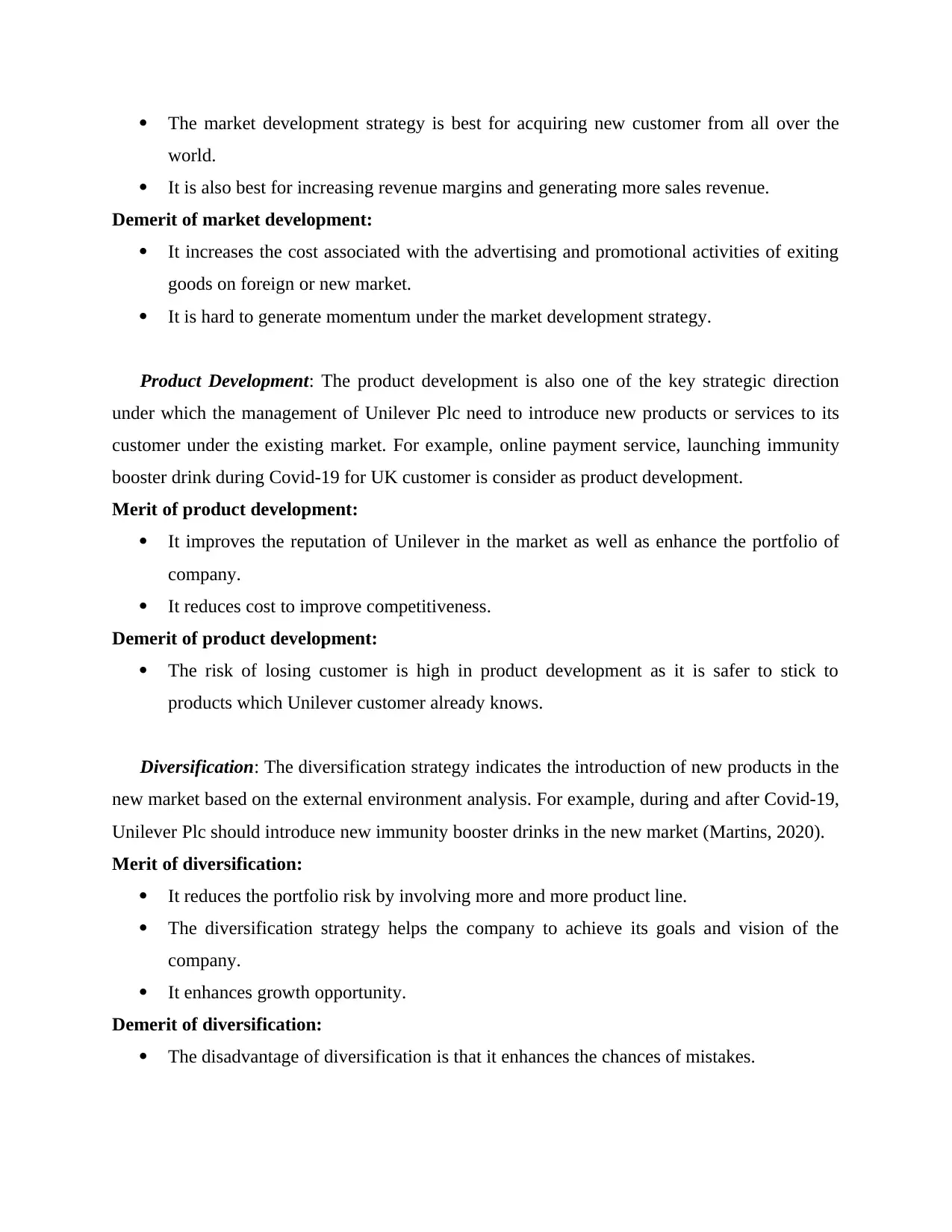
The market development strategy is best for acquiring new customer from all over the
world.
It is also best for increasing revenue margins and generating more sales revenue.
Demerit of market development:
It increases the cost associated with the advertising and promotional activities of exiting
goods on foreign or new market.
It is hard to generate momentum under the market development strategy.
Product Development: The product development is also one of the key strategic direction
under which the management of Unilever Plc need to introduce new products or services to its
customer under the existing market. For example, online payment service, launching immunity
booster drink during Covid-19 for UK customer is consider as product development.
Merit of product development:
It improves the reputation of Unilever in the market as well as enhance the portfolio of
company.
It reduces cost to improve competitiveness.
Demerit of product development:
The risk of losing customer is high in product development as it is safer to stick to
products which Unilever customer already knows.
Diversification: The diversification strategy indicates the introduction of new products in the
new market based on the external environment analysis. For example, during and after Covid-19,
Unilever Plc should introduce new immunity booster drinks in the new market (Martins, 2020).
Merit of diversification:
It reduces the portfolio risk by involving more and more product line.
The diversification strategy helps the company to achieve its goals and vision of the
company.
It enhances growth opportunity.
Demerit of diversification:
The disadvantage of diversification is that it enhances the chances of mistakes.
world.
It is also best for increasing revenue margins and generating more sales revenue.
Demerit of market development:
It increases the cost associated with the advertising and promotional activities of exiting
goods on foreign or new market.
It is hard to generate momentum under the market development strategy.
Product Development: The product development is also one of the key strategic direction
under which the management of Unilever Plc need to introduce new products or services to its
customer under the existing market. For example, online payment service, launching immunity
booster drink during Covid-19 for UK customer is consider as product development.
Merit of product development:
It improves the reputation of Unilever in the market as well as enhance the portfolio of
company.
It reduces cost to improve competitiveness.
Demerit of product development:
The risk of losing customer is high in product development as it is safer to stick to
products which Unilever customer already knows.
Diversification: The diversification strategy indicates the introduction of new products in the
new market based on the external environment analysis. For example, during and after Covid-19,
Unilever Plc should introduce new immunity booster drinks in the new market (Martins, 2020).
Merit of diversification:
It reduces the portfolio risk by involving more and more product line.
The diversification strategy helps the company to achieve its goals and vision of the
company.
It enhances growth opportunity.
Demerit of diversification:
The disadvantage of diversification is that it enhances the chances of mistakes.
Paraphrase This Document
Need a fresh take? Get an instant paraphrase of this document with our AI Paraphraser
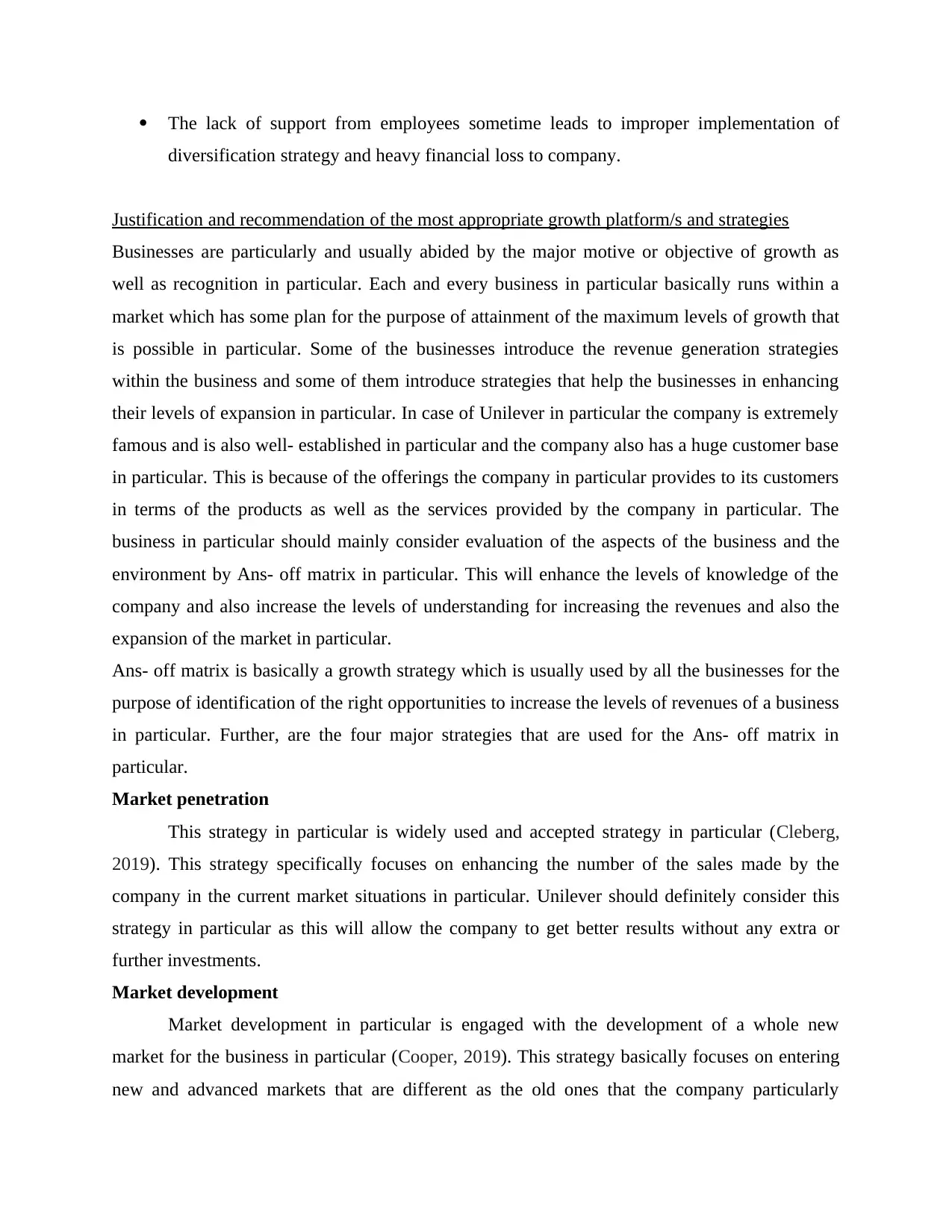
The lack of support from employees sometime leads to improper implementation of
diversification strategy and heavy financial loss to company.
Justification and recommendation of the most appropriate growth platform/s and strategies
Businesses are particularly and usually abided by the major motive or objective of growth as
well as recognition in particular. Each and every business in particular basically runs within a
market which has some plan for the purpose of attainment of the maximum levels of growth that
is possible in particular. Some of the businesses introduce the revenue generation strategies
within the business and some of them introduce strategies that help the businesses in enhancing
their levels of expansion in particular. In case of Unilever in particular the company is extremely
famous and is also well- established in particular and the company also has a huge customer base
in particular. This is because of the offerings the company in particular provides to its customers
in terms of the products as well as the services provided by the company in particular. The
business in particular should mainly consider evaluation of the aspects of the business and the
environment by Ans- off matrix in particular. This will enhance the levels of knowledge of the
company and also increase the levels of understanding for increasing the revenues and also the
expansion of the market in particular.
Ans- off matrix is basically a growth strategy which is usually used by all the businesses for the
purpose of identification of the right opportunities to increase the levels of revenues of a business
in particular. Further, are the four major strategies that are used for the Ans- off matrix in
particular.
Market penetration
This strategy in particular is widely used and accepted strategy in particular (Cleberg,
2019). This strategy specifically focuses on enhancing the number of the sales made by the
company in the current market situations in particular. Unilever should definitely consider this
strategy in particular as this will allow the company to get better results without any extra or
further investments.
Market development
Market development in particular is engaged with the development of a whole new
market for the business in particular (Cooper, 2019). This strategy basically focuses on entering
new and advanced markets that are different as the old ones that the company particularly
diversification strategy and heavy financial loss to company.
Justification and recommendation of the most appropriate growth platform/s and strategies
Businesses are particularly and usually abided by the major motive or objective of growth as
well as recognition in particular. Each and every business in particular basically runs within a
market which has some plan for the purpose of attainment of the maximum levels of growth that
is possible in particular. Some of the businesses introduce the revenue generation strategies
within the business and some of them introduce strategies that help the businesses in enhancing
their levels of expansion in particular. In case of Unilever in particular the company is extremely
famous and is also well- established in particular and the company also has a huge customer base
in particular. This is because of the offerings the company in particular provides to its customers
in terms of the products as well as the services provided by the company in particular. The
business in particular should mainly consider evaluation of the aspects of the business and the
environment by Ans- off matrix in particular. This will enhance the levels of knowledge of the
company and also increase the levels of understanding for increasing the revenues and also the
expansion of the market in particular.
Ans- off matrix is basically a growth strategy which is usually used by all the businesses for the
purpose of identification of the right opportunities to increase the levels of revenues of a business
in particular. Further, are the four major strategies that are used for the Ans- off matrix in
particular.
Market penetration
This strategy in particular is widely used and accepted strategy in particular (Cleberg,
2019). This strategy specifically focuses on enhancing the number of the sales made by the
company in the current market situations in particular. Unilever should definitely consider this
strategy in particular as this will allow the company to get better results without any extra or
further investments.
Market development
Market development in particular is engaged with the development of a whole new
market for the business in particular (Cooper, 2019). This strategy basically focuses on entering
new and advanced markets that are different as the old ones that the company particularly

operated in. Unilever being a company that has expanded in different countries and markets
already has implemented this strategy.
Product development
Product development is particularly a strategy that is associated with bringing new
product in the market in particular. The market remains the same in this situation but the product
line expands which means new products are added in particular. The growth of the business in
such a situation totally depends on the acceptance of the product from the side of the market in
particular. Unilever should adopt this strategy to increase its target market as well.
Diversification
Diversification is considered to be the most dangerous strategy in particular. This is
mixture of both change in the product as well as the market in particular. This strategy brings a
huge risk of failure for the company in particular.
Evaluate ways and means by which the chosen strategy/ies can be monitored in order to ensure
success
Monitoring the performance of an organization is very important step as its generally shows the
actual progress of the organization as well as the strategies that mainly are used to serve a
specific purpose. Monitoring is way to check that strategies that are generally made for the
purpose are actually serving the design in an organization or not. The company can take the key
performance indicators to track the performance of the company to the standard one. Monitoring
is an important because by this the business can track their performance, so they will take
corrective action on time. By the KPI the organization can easily know they are going in the right
direction or not. As well as take action if they need. So by the key performance indicators the
company can track that their strategies are going in the direction of achieving the objective as
well as goals or not.
The financial performance of the organization clearly display that the strategies made for the
organization growth is mainly resulting in the progress or not. Unilever can balance their
strategies accordingly, either by reviewing its financial performance or even by analysing the
need or requirement of the organization. Stakeholder performance is an process that is generally
linked with the financial projection. This is mainly kind of component in the balance scorecard,
which also focuses on reviewing the performance of the stakeholders as well as craft the
already has implemented this strategy.
Product development
Product development is particularly a strategy that is associated with bringing new
product in the market in particular. The market remains the same in this situation but the product
line expands which means new products are added in particular. The growth of the business in
such a situation totally depends on the acceptance of the product from the side of the market in
particular. Unilever should adopt this strategy to increase its target market as well.
Diversification
Diversification is considered to be the most dangerous strategy in particular. This is
mixture of both change in the product as well as the market in particular. This strategy brings a
huge risk of failure for the company in particular.
Evaluate ways and means by which the chosen strategy/ies can be monitored in order to ensure
success
Monitoring the performance of an organization is very important step as its generally shows the
actual progress of the organization as well as the strategies that mainly are used to serve a
specific purpose. Monitoring is way to check that strategies that are generally made for the
purpose are actually serving the design in an organization or not. The company can take the key
performance indicators to track the performance of the company to the standard one. Monitoring
is an important because by this the business can track their performance, so they will take
corrective action on time. By the KPI the organization can easily know they are going in the right
direction or not. As well as take action if they need. So by the key performance indicators the
company can track that their strategies are going in the direction of achieving the objective as
well as goals or not.
The financial performance of the organization clearly display that the strategies made for the
organization growth is mainly resulting in the progress or not. Unilever can balance their
strategies accordingly, either by reviewing its financial performance or even by analysing the
need or requirement of the organization. Stakeholder performance is an process that is generally
linked with the financial projection. This is mainly kind of component in the balance scorecard,
which also focuses on reviewing the performance of the stakeholders as well as craft the
⊘ This is a preview!⊘
Do you want full access?
Subscribe today to unlock all pages.

Trusted by 1+ million students worldwide
1 out of 14
Related Documents
Your All-in-One AI-Powered Toolkit for Academic Success.
+13062052269
info@desklib.com
Available 24*7 on WhatsApp / Email
![[object Object]](/_next/static/media/star-bottom.7253800d.svg)
Unlock your academic potential
Copyright © 2020–2025 A2Z Services. All Rights Reserved. Developed and managed by ZUCOL.

